Executive Summary
As 2022 comes to a close, I am once again so thankful to all of you, the ever-growing number of readers who continue to regularly visit this Nerd’s Eye View Blog (and share the content with your friends and colleagues, which we greatly appreciate!). This year has been challenging for many financial advisors as they help their clients (and their own firms!) navigate a volatile market environment (in both stocks and bonds – oof!) and inflation levels not seen in several decades. Personally, it has been a big year of change as well, with the Kitces.com platform adding new team members, rolling out a new IAR CE offering and our latest Estate Planning course, and introducing the AdvisorTech Directory, among other additions, to fulfill our own mission of “Making Financial Advicers Better and More Successful”.
We recognize (and appreciate!) that this blog – its articles and podcasts – is a regular habit for tens of thousands of advisors, but that not everyone has the time or opportunity to read every blog post or listen to every podcast that is released from Nerd’s Eye View throughout the year. As many of you noted in response to our Reader Surveys, most choose which content to read or listen to based on headlines and topics that are of interest (and skip the rest). Yet in practice, this means that an article once missed is often never seen again, ‘overwritten’ (or at least bumped out of your Inbox!) by the next day’s, week’s, and month’s worth of content that comes along.
Accordingly, just as I did last year, and in 2020, 2019, 2018, 2017, 2016, 2015, and 2014, I've compiled for you this Highlights List of our top 20 articles in 2022 that you might have missed, along with a few of our most popular episodes of ‘Kitces & Carl’ and the ‘Financial Advisor Success’ podcasts. So whether you’re new to the blog and #FASuccess (and Kitces & Carl) podcasts and haven’t searched through the Archives yet, or simply haven’t had the time to keep up with everything, I hope that some of these will (still) be useful for you! And as always, I hope you’ll take a moment to share podcast episodes and articles of interest with your friends and colleagues as well!
Don’t miss our Annual Guides as well – including our list of the “9 'Best' Financial Advisor Conferences (For Scaling Up) In 2023”, the ever-popular annual “2022 Reading List of Best Books For Financial Advisors”, and our increasingly popular Financial Advisor “FinTech” Solutions Map and AdvisorTech Directory!
In the meantime, I hope you're having a safe and happy holiday season. Thanks again for the opportunity to serve you in 2022, and I’m excited to share more soon about some new initiatives we’re planning to do to support the Financial Advicer community even more in 2023 and beyond!
Financial Planning
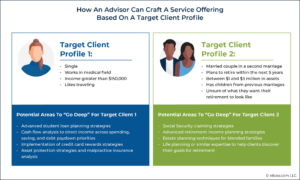 101 Things That Advisors Actually DO To Add Value (Beyond Just Allocating A Portfolio) – Traditionally, investment planning has been at the forefront of how financial advisors add value for their clients. But, with the rise of index funds and the commoditization of investment advice, generating sufficient investment ‘alpha’ to justify a fee has become more challenging for advisors. Combined with growing advisor (and consumer) interest in comprehensive financial planning services, the number of ways advisors can add value for their clients has expanded greatly.
101 Things That Advisors Actually DO To Add Value (Beyond Just Allocating A Portfolio) – Traditionally, investment planning has been at the forefront of how financial advisors add value for their clients. But, with the rise of index funds and the commoditization of investment advice, generating sufficient investment ‘alpha’ to justify a fee has become more challenging for advisors. Combined with growing advisor (and consumer) interest in comprehensive financial planning services, the number of ways advisors can add value for their clients has expanded greatly.
When an advisor is thinking about their value proposition for clients, they might be tempted to list as many planning value-adds as they possibly can (to reach the broadest possible base of potential clients). But this can create challenges for the advisor as well, as they will have to spend significant time managing the variability of the planning needs of their diverse client base. An alternate approach, however, is for the advisor to focus their client service proposition on the planning needs of a specific target client.
To start crafting the persona of their ideal client, advisors can list key attributes of their target client. For advisors at established firms, this could mean thinking about their top clients, while those starting new firms could think about the type of clients they would like to serve (whether based on age, occupation, personal affinities, or other criteria). Once an advisor has a better idea of who their target client is, they can then consider how to tailor their value proposition to those clients. Because the advisor’s target client will probably only have certain planning needs (and may not require others), advisors can focus their energy by ‘going deep’ in a certain subset of value-adds out of the hundreds of options available.
Ultimately, the key point is that while there are more than 100 different ways to add value to their clients’ lives, by applying an ideal-target-client framework to focus their service offering on certain planning areas, advisors can not only better target their marketing efforts (as they can align their website and other advertising efforts with their ideal client’s needs), but they can also streamline their day-to-day work, as they will encounter fewer ‘new’ issues as their client base grows!
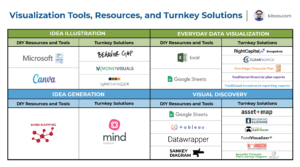 Creating Visual Deliverables That Clearly Communicate Financial Planning Concepts – While technical expertise is necessary to formulate a financial plan, being able to clearly communicate the findings to a client can make all the difference between whether or not the client will understand and agree to implement the advisor’s recommendations. Many advisors are accustomed to using verbal communication with clients (e.g., in client meetings) and written communication (e.g., through the delivery of a written plan); however, some concepts are difficult to explain and understand through these means. But by using visualization aids in their communication, advisors can clarify complex information and generate better conversations with clients.
Creating Visual Deliverables That Clearly Communicate Financial Planning Concepts – While technical expertise is necessary to formulate a financial plan, being able to clearly communicate the findings to a client can make all the difference between whether or not the client will understand and agree to implement the advisor’s recommendations. Many advisors are accustomed to using verbal communication with clients (e.g., in client meetings) and written communication (e.g., through the delivery of a written plan); however, some concepts are difficult to explain and understand through these means. But by using visualization aids in their communication, advisors can clarify complex information and generate better conversations with clients.
In this guest post, Michael Lecours offers a variety of potential self-generated visualizations for advisors, as well as a range of available turnkey software solutions or white-labeled products advisors, from One Page Financial Plans to Clearnomics chartbooks to Investments Illustrated and Lecours’ own fpPathfinder for advisor flowcharts and checklists, that can be used to most effectively communicate information to clients (and of course, Kitces.com Premier Members have access to the entire Kitces Graphics Library, too!).
Notably, when considering how to use visualizations, it is important to recognize that different styles of visualization can be used to meet different communication objectives. For instance, visualizations can be categorized based on their content (conceptual or data-driven) and purpose (declarative or exploratory), which can then be used to choose an appropriate style of visualization to implement (e.g., a chart or graph objectively illustrating relationships between facts and figures for data-driven, declarative ideas or conveying a conceptual, exploratory idea through an ‘idea generation’ visualization).
The key point is that visualizations can be useful tools for improving advisor communication and client comprehension. Because given the data-intensive nature of financial plans, visualizations can serve as a useful complement to written and verbal communication from the advisor and can provide clarity to clients, which can give clients more confidence in their plans… and in their advisors!
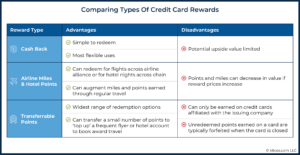 Credit Card Rewards Strategies: How To Maximize Benefits And Add Client Value – Despite the ubiquity of credit cards in the United States, many consumers might not be aware that they can earn thousands of dollars in cash-back rewards or travel benefits each year through a combination of credit card sign-ups and regular spending (to the ‘right’ credit cards). Accordingly, financial advisors have an opportunity to provide significant ongoing value to clients by investing effort into helping clients find the best card(s) to maximize rewards based on their personal spending habits. Which, given the lifestyle of many clients – and the amount of credit card rewards they can earn from that spending – can materially offset a financial advisor’s ongoing fees, or result in a really nice ‘free’ vacation for the client every year (courtesy of their advisor’s advice!)!
Credit Card Rewards Strategies: How To Maximize Benefits And Add Client Value – Despite the ubiquity of credit cards in the United States, many consumers might not be aware that they can earn thousands of dollars in cash-back rewards or travel benefits each year through a combination of credit card sign-ups and regular spending (to the ‘right’ credit cards). Accordingly, financial advisors have an opportunity to provide significant ongoing value to clients by investing effort into helping clients find the best card(s) to maximize rewards based on their personal spending habits. Which, given the lifestyle of many clients – and the amount of credit card rewards they can earn from that spending – can materially offset a financial advisor’s ongoing fees, or result in a really nice ‘free’ vacation for the client every year (courtesy of their advisor’s advice!)!
For advisors, cash flow discussions with clients can be a good opportunity to broach suitable credit card reward programs, as advisors can discuss not only what clients are purchasing but also how they are paying for those purchases. This can reveal important information to help advisors craft a sensible rewards strategy for clients, including the client’s regular credit card spending (to gauge their ability to meet spending requirements for sign-up bonuses), which categories of purchases (e.g., groceries, gas) they make most often (to find cards that offer bonus rewards in these categories), and whether they are planning any large 1-time expenses (that could be used to meet sign-up bonus spending requirements by themselves).
In addition to understanding a client’s spending patterns, it is also important to gauge their interest in managing credit card rewards on an ongoing basis. Because while some clients might be interested in applying for multiple new cards each year to build up points and miles through sign-up bonuses, others might be less interested in applying for cards and would instead prefer earning rewards on a single card. Either option can be profitable for the client, but it is important for advisors to understand their clients’ preferences for credit card rewards strategies to ensure they are comfortable with the process (so that it will be easier for them to stick to the strategy in the first place!).
Ultimately, the key point is that working with clients to devise a credit card spending strategy that maximizes available rewards can help advisors demonstrate ongoing value to attract and retain clients. Because, at the end of the day, what client wouldn’t want to work with an advisor who can help send them on a really nice ‘free’ vacation each year?
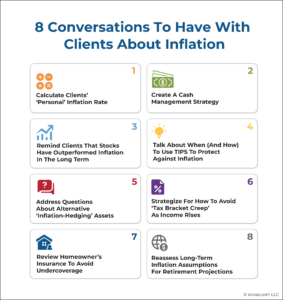 8 Inflation Conversations For Financial Advisors To Have With Clients – One of the hot topics for advisors and their clients throughout 2022 has been the persistently high inflation experienced in the United States, which has reached levels not seen since the early 1980s. While it is unclear how long inflation will remain elevated, continued rising prices may have many advisors (and their clients) wondering if there is more that they can do to better position themselves for a prolonged bout with inflation.
8 Inflation Conversations For Financial Advisors To Have With Clients – One of the hot topics for advisors and their clients throughout 2022 has been the persistently high inflation experienced in the United States, which has reached levels not seen since the early 1980s. While it is unclear how long inflation will remain elevated, continued rising prices may have many advisors (and their clients) wondering if there is more that they can do to better position themselves for a prolonged bout with inflation.
One place to start may be to better understand how inflation is personally affecting each client, as different households experience inflation in different ways depending on their lifestyle and where they live. With this in mind, advisors can help clients calculate their own ‘personal’ inflation rate (and the article includes a downloadable template to make it easier to do so).
Another immediate way that advisors can help ease the impact of inflation for clients is to create a cash management strategy (i.e., where and how will clients hold their ‘excess’ cash and emergency reserves to maximize ongoing interest earnings), which has perhaps become more important as interest rates have risen throughout the year, widening the spread between different cash management options (and the potential additional earnings opportunities for clients). In addition, advisors can also address different ways clients can protect their savings for retirement and other long-term goals against inflation, including U.S. stocks (which have a lengthy track record of outperforming inflation over long time horizons) and Treasury Inflation-Protected Securities (TIPS). Advisors can also discuss the track records of other types of assets that are often associated with hedging inflation risk – such as gold, commodities, Real Estate Investment Trusts (REITs), and, most recently, cryptocurrencies.
In the end, even though the goal of many advisors in the current environment may be to encourage clients to continue to stay the course and avoid making rash decisions, there are still concrete ways that advisors can help clients better position themselves to withstand the current spike of inflation and improve their situation for the long term without drastically altering their existing plans!
Business Management
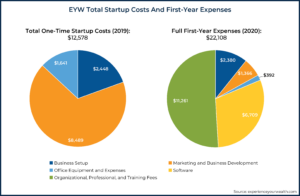 7 Lessons Learned After Building A Fee-Only Financial Planning Firm From Scratch – Launching an RIA can be a rewarding experience for advisors who desire the independence, flexibility, and control of owning an advisory practice. At the same time, the process of establishing a new business can be daunting, especially when the firm is ‘truly’ starting from scratch with zero clients, revenue, or infrastructure.
7 Lessons Learned After Building A Fee-Only Financial Planning Firm From Scratch – Launching an RIA can be a rewarding experience for advisors who desire the independence, flexibility, and control of owning an advisory practice. At the same time, the process of establishing a new business can be daunting, especially when the firm is ‘truly’ starting from scratch with zero clients, revenue, or infrastructure.
In this guest post, Jake Northrup, founder of Experience Your Wealth, LLC, relays some of the lessons he learned himself during the first 3 years of building his own fee-only RIA firm from scratch, to help advisors who are thinking about launching their own firms understand how they can navigate the early pitfalls of owning an advisory practice.
Notably, launching an RIA is not only a business decision; it is also a personal decision that can reshape many aspects of an advisor’s life, from choosing where and when to work to the potential need to tap into their own personal savings to keep it running (at least until the firm generates enough revenue to cover both its own business expenses and the owner’s personal expenses). For aspiring firm owners, then, understanding why starting an RIA from scratch is worth the risks is a crucial step in creating a practice that supports the ideal life that the owner wants.
Ultimately, though, what’s important to remember for aspiring advisory firm owners is that virtually everything about the firm – from its fee structure to its target niche and even to the owner’s long-term vision – can change. Because while it’s important for new firm owners to plan out how the business will look and operate in its first few years, perhaps even more vital is to build in flexibility to account for how the firm’s vision will change over that time, especially since the flexibility to make firm decisions itself is often one of the main reasons advisors choose to start their own practice in the first place!
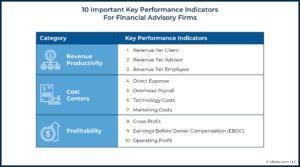 10 Key Performance Indicators For Financial Advisory Firms To Compare With Industry Benchmarking Studies – Industry benchmarking studies can be a valuable tool for advisory firm owners to make better business decisions. By compiling and publishing data on firms across the industry, the studies enable owners to compare their firms’ performance side by side against that of their peers, giving the owners an expectation for how their firms should or could be performing, and insight into where they might be outperforming (or underperforming) the competition.
10 Key Performance Indicators For Financial Advisory Firms To Compare With Industry Benchmarking Studies – Industry benchmarking studies can be a valuable tool for advisory firm owners to make better business decisions. By compiling and publishing data on firms across the industry, the studies enable owners to compare their firms’ performance side by side against that of their peers, giving the owners an expectation for how their firms should or could be performing, and insight into where they might be outperforming (or underperforming) the competition.
In addition, taking a systematic approach towards participating in and using industry benchmarking studies also indirectly helps advisory firm owners overcome the challenges of collecting, organizing, and comparing their firm’s data. As by organizing the firm’s financial data to efficiently compare with major industry benchmarking studies, the firm owner is guided toward what key metrics the business should be tracking that are the most relevant to glean insights about the firm’s productivity, efficiency, and profitability.
Furthermore, technological tools are emerging that can help reduce some of the time and resource burden on firm owners to track and analyze their financial data. 2 such tools – AdvisorClarity and Truelytics – automate different parts of the process, and (depending on which part of the process the firm owner prefers to automate) both tools allow the firm owner to glean insight from benchmarking comparisons with less of an investment in time and resources.
The key point is that firm owners can use benchmarking data to better understand how they can improve their business. By having an ‘average’ to compare against, it is possible to quickly see where these improvements can be made – meaning that the initial time investment of using benchmarking studies could ultimately save the firm owner a lot of time and effort in making their firm more productive and profitable!
Not All Equity Owners Will Act Like Owners: 3 Pathways To Create Psychological Ownership – Financial advisory firm owners often seek to instill a sense of ownership in the firm’s success in their employees to encourage hard work and retention. And while many firms choose to do so by granting their employees an equity stake in the firm, this is not the only way to build a culture of ‘ownership’ in the firm’s success.
Under a framework proposed by Finnish management scientist Antti Talonen, employees are more likely to feel like owners, particularly over the part of the business they control, if 1 of 3 ‘pathways’ to psychological ownership applies to them: 1) they have controlled some part of the business for an extended period; 2) they have generated an intimate knowledge of the business; or 3) they have invested their personal resources or effort into the business.
Accordingly, when it comes to advisory firms, creating a sense of psychological ownership among employees can arise from having a sense of at least some level of control over the firm, being intimately familiar with and involved in the firm’s operations, or investing significant amounts of energy, time, and effort to the firm. Team members who meet at least one of these preconditions are likely to feel (and behave!) like owners, whether or not they have legal ownership in the firm as well.
Further, while it might be tempting for firms to err on the side of inclusivity and broaden legal ownership in the firm, there are costs involved in doing so. For example, not only can extending ownership to employees increase the legal, administrative, and tax burdens for both the firm and its owners, but it can also raise the risk to employee morale. As high-performing employees may be disheartened if they feel they are being treated the same as those with poor performance (because the firm is ‘too’ generous with sharing equity), above-average (but not exceptional) employees may be disheartened if they feel access to equity is too restrictive (limited only to ‘superstars’ in the firm) and out of their reach… making the balancing point a difficult one to find.
Ultimately, the key point for advisors is that the concept of ownership is multifaceted and goes beyond legal ownership in a firm. Developing a sense of psychological ownership among employees can make them feel more vested in taking care of the business and ensuring its success, even in the absence of legal ownership of shares in the business!
Sales & Marketing
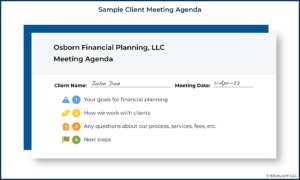 The 30-Minute Prospect Meeting: A Framework And Agenda That Convert By Focusing On The Prospect’s (Immediate) Problem – In recent years, financial advisors have increasingly recognized that making a personal connection with prospective clients early in the process can make it more likely that the prospect will eventually become an engaged, motivated client. Which means that advisors often get personal with prospects early – in many cases, asking them questions about their personal memories, attitudes, and psychology around money with the aim of showing interest in the prospect as a person beyond the numbers on their balance sheet. But in reality, prospects also may have priorities on their minds going into the initial meeting other than their psychology around money. Often, there is a significant, concrete problem in their financial life that has pushed them to reach out to a financial advisor.
The 30-Minute Prospect Meeting: A Framework And Agenda That Convert By Focusing On The Prospect’s (Immediate) Problem – In recent years, financial advisors have increasingly recognized that making a personal connection with prospective clients early in the process can make it more likely that the prospect will eventually become an engaged, motivated client. Which means that advisors often get personal with prospects early – in many cases, asking them questions about their personal memories, attitudes, and psychology around money with the aim of showing interest in the prospect as a person beyond the numbers on their balance sheet. But in reality, prospects also may have priorities on their minds going into the initial meeting other than their psychology around money. Often, there is a significant, concrete problem in their financial life that has pushed them to reach out to a financial advisor.
In the initial prospect meeting, then, all that really matters is answering this question for the prospect: “Can – and how will – this advisor be able to solve my immediate problem?”. The advisor can help the prospect answer this question by focusing on that problem for the entire meeting: first, by learning what caused the prospect to initially reach out and exploring that problem in depth; then by describing the advisor’s services and planning process, specifically as it relates to solving that problem. And by focusing solely on the prospect’s problem, advisors can hold an efficient initial prospect meeting – lasting around just 30 minutes – that gets to what really matters for the prospect and gives both parties the information they need to decide how to move forward.
In the end, it’s important to remember that prospective clients often don’t want to talk about the broad benefits of financial planning and what an advisor can do to help them; instead, they want to focus on the problem that has caused them to reach out in the first place. Which suggests that creating a space for the prospect and letting them talk freely about what is important to them at that moment – with the advisor listening empathetically and reflecting that information back to them – can ultimately establish the personal connection that many prospects seek, creating a foundation of trust to build on, and most readily showing the prospective client how the advisor can provide the most immediate and meaningful help!
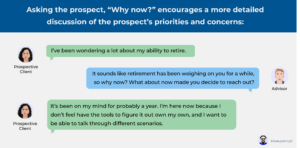 “Why Now?”: One Question Financial Advisors Should Ask To Convert Prospects Into Clients – For financial advisors, one of the main challenges of the initial meeting with a prospective client is demonstrating the value of financial advice – and showing the prospect how they would benefit from becoming a client. Yet, in reality, advisors don’t necessarily have to try to show all the different ways that they might provide help and hope one resonates with the client; instead, by understanding what led the prospect to reach out, prospects will often divulge all by themselves what would be most motivating for them to take action and hire the advisor!
“Why Now?”: One Question Financial Advisors Should Ask To Convert Prospects Into Clients – For financial advisors, one of the main challenges of the initial meeting with a prospective client is demonstrating the value of financial advice – and showing the prospect how they would benefit from becoming a client. Yet, in reality, advisors don’t necessarily have to try to show all the different ways that they might provide help and hope one resonates with the client; instead, by understanding what led the prospect to reach out, prospects will often divulge all by themselves what would be most motivating for them to take action and hire the advisor!
One straightforward way for advisors to explore this is simply to ask the prospect what has caused them to reach out to hire a financial advisor at this particular moment. The “Why now?” approach identifies important nuances around the prospect’s specific pain points, which helps the advisor understand their deeper concerns beyond a generic need for financial advice. Then, having identified those concerns, the advisor can better understand what the prospect really values – and can subsequently tailor their own value proposition in a way that truly resonates with the prospect’s particular problems and concerns.
In addition, this approach sets the stage for good follow-up questions (e.g., whether they have ever worked with a financial professional before). By inviting the prospect to go deeper into how they might be struggling with whatever prompted them to reach out, the advisor can let the prospect articulate – in their own words – why they need financial advice and how the advisor can help them resolve their immediate pain points.
Ultimately, it’s important to remember that every prospect has (at least) one reason for reaching out and that there are unique ways they can benefit from the advisor’s services. By identifying those reasons, understanding how the prospect wants to be helped, and clarifying the urgency that prompted the prospect to make contact in the first place, the advisor can personalize their response by articulating their value in a way that will resonate with the prospect, and that connects to solving their problems (all while affirming the prospect’s reason for being there in the first place!).
Regulatory
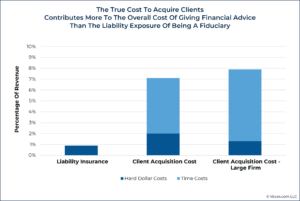 The Market For “Lemons” In Financial Advice: How Higher Standards Can Lower Costs And Increase Access To Advice – In a now-famous 1970 paper, economist George Akerlof used the market for used cars to demonstrate the negative effects that can occur when there are significant information asymmetries between buyers and sellers of a good or service. And while Akerlof highlighted problems in the used-car market (where consumers’ inability to identify poor-quality “lemons” drove prices down for high-quality “peaches”, eventually driving good providers out of the market as they were unable to charge for their full value, and allowing low-quality providers to dominate), the financial advisory industry is not immune to the same problems.
The Market For “Lemons” In Financial Advice: How Higher Standards Can Lower Costs And Increase Access To Advice – In a now-famous 1970 paper, economist George Akerlof used the market for used cars to demonstrate the negative effects that can occur when there are significant information asymmetries between buyers and sellers of a good or service. And while Akerlof highlighted problems in the used-car market (where consumers’ inability to identify poor-quality “lemons” drove prices down for high-quality “peaches”, eventually driving good providers out of the market as they were unable to charge for their full value, and allowing low-quality providers to dominate), the financial advisory industry is not immune to the same problems.
For example, given the wide range of professionals who can call themselves ‘financial advisors’ – from someone whose business is selling insurance policies to a financial planner who sells financial advice itself – consumers can have difficulty understanding the type and quality of service they will receive from a given ‘advisor’. Which increases the costs for an advisory firm to get clients in the first place, driving up the cost of advice (a cost that is less problematic for those who sell high-commission products, where there are more than enough profits to absorb the higher marketing costs!).
In turn, this suggests that if standards in the market for advisors were raised by restricting who can hold themselves out as a financial advisor (thereby increasing consumer trust in anyone who can actually use the title), exceptional advisors could spend less money on differentiating themselves from advisors with lower standards, creating the opportunity for reduced marketing and business expenses (that could more than offset the entire cost of fiduciary liability insurance from those higher standards!). Which could then be passed along in the form of lower costs for consumers (potentially opening up advice to a wider pool of clients!) and even allow for higher quality advisors to enter the market cost-effectively.
Building off of Akerlof’s research, potential strategies to counteract the effects of quality uncertainty and increase consumer confidence in advisors could include licensing (e.g., establishing a requirement involving a professional designation like the CFP certification for those who provide financial advice), a quality guarantee (perhaps through a broad-based fiduciary standard) and branding/holding-out restrictions (e.g., limiting the use of the title “financial advisor” and “financial planner” to those who are solely in the business of providing advice and who meet certain competence and ethical standards).
Ultimately, the key point is that information asymmetries that reduce consumer trust are common in the financial advisory marketplace, and raising industry standards of conduct could not only improve consumer confidence in advisors but also reduce marketing costs for advisors trying to gain consumer trust!
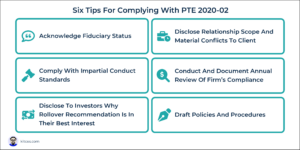 Complying With PTE 2020-02 Under DoL’s New IRA Rollover Requirements – As of February 1, 2022, financial advisors who give advice to clients about whether to roll over 401(k) plan assets into an IRA are subject to a new set of regulations from the U.S. Department Of Labor (DOL). Specifically, advisors who would receive increased compensation as a result of recommending a rollover (such as a commission or advisory fee) must qualify for an exemption from DOL’s prohibited transaction rules by complying with the new standards outlined by DOL.
Complying With PTE 2020-02 Under DoL’s New IRA Rollover Requirements – As of February 1, 2022, financial advisors who give advice to clients about whether to roll over 401(k) plan assets into an IRA are subject to a new set of regulations from the U.S. Department Of Labor (DOL). Specifically, advisors who would receive increased compensation as a result of recommending a rollover (such as a commission or advisory fee) must qualify for an exemption from DOL’s prohibited transaction rules by complying with the new standards outlined by DOL.
At a basic level, PTE 2020-02 expands the definition of a “prohibited transaction” under ERISA to include any recommendation for rolling over 401(k) plan assets into an IRA (or from one IRA to another) when doing so would increase the compensation for the advisor. In practice, this would prohibit most independent financial advisors from working with clients doing IRA rollovers altogether; however, advisors can still work with retiring clients and their rollovers by taking steps to qualify for a “prohibited transaction exemption (PTE), which effectively becomes the de-facto standard that advisors must then meet to engage in such rollovers. In order to qualify for the PTE on IRA rollovers, advisors must comply with 6 key conditions, which include, among others, acknowledging that they are fiduciaries under ERISA and providing written disclosures to clients of why the recommendation to roll over assets is in their best interests.
While many advisors may already be following some of these conditions (e.g., RIAs who have fiduciary status by virtue of the SEC’s fiduciary obligation for investment advisers may already acknowledge that status in writing), the DOL has its own specific requirements, including model language to use in disclosure documents, that are required to comply with the specifically prohibited transaction exemption.
Nevertheless, RIAs may be able to easily adapt their existing disclosure documents, such as Forms ADV and CRS, to satisfy the first 2 requirements. And so, while complying with PTE 2020-02 might seem daunting when viewed in its entirety, doing so can be more manageable by breaking it down into its individual components and determining where the advisor’s existing processes and tools can be used or adapted!
Wellbeing
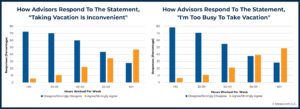 How To Take More Vacation: An Advisor’s Guide To Balancing Work And Time Off – Taking time away from the office can have many benefits for advisors (from spending time with family to avoiding professional burnout). At the same time, being away from work means having less time for client engagement, business development, and other firm activities. Which raises the question of how advisors can most effectively balance their work obligations with the benefits of taking time off.
How To Take More Vacation: An Advisor’s Guide To Balancing Work And Time Off – Taking time away from the office can have many benefits for advisors (from spending time with family to avoiding professional burnout). At the same time, being away from work means having less time for client engagement, business development, and other firm activities. Which raises the question of how advisors can most effectively balance their work obligations with the benefits of taking time off.
Which matters, as according to the latest Kitces Research study on Advisor Wellbeing, work hours and vacation days are correlated with adviser wellbeing. For instance, the study found that advisors who reported very low quality-of-life scores took about 15 vacation days each year and worked about 43 hours per week, while advisors with very high quality-of-life scores took 29 vacation days each year and worked 38 hours per week. Simply put, figuring out how to work fewer hours each week and take more vacation really matters when it comes to advisor wellbeing.
Given the various benefits of having time away from work, advisors have several options to reduce their weekly work hours and add vacation days to their calendars. For instance, designating a schedule based on realistic working hours can help them structure their time in a way that will help them meet their goal – in essence, by declaring to themselves that they will only work certain specified hours, the advisor will intuitively begin to better prioritize and make adjustments (and figure out what to stop doing to free up more time for themselves). Also, setting expectations for clients is especially important, both in terms of the advisor’s (lack of) availability on vacation days and during the workweek (which advisors can do by including their availability for replies in their email signature), as often the biggest constraint to taking more vacation is a self-imposed burden to ‘always’ be available to clients instead of setting more realistic (and healthy) expectations. Another option is to bring on new employees to share the work burden, which can both free up time for firm owners and provide essential coverage of the office when they’re out on vacation.
Ultimately, the key point is that taking time away from the office is a key contributor to an advisor's overall wellbeing. And for advisors who would like to work fewer hours per week or take more vacation days (or both!), setting clear expectations with clients and co-workers that the advisor will not always be available – and that’s OK! – is an important first step toward creating more high-quality free time!
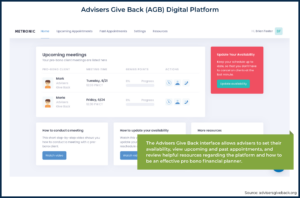 Serving Pro Bono Clients As A Busy Advisor: How ‘Advisers Give Back’ Makes Volunteering Easy – While new fee models have allowed fee-only advisors to reach an expanding range of potential clients, there are many Americans who could benefit from professional financial advice but might not have sufficient income or assets to pay for it. This gives advisors the opportunity to engage in pro bono financial planning: free, no-strings-attached financial advice and planning for underserved individuals.
Serving Pro Bono Clients As A Busy Advisor: How ‘Advisers Give Back’ Makes Volunteering Easy – While new fee models have allowed fee-only advisors to reach an expanding range of potential clients, there are many Americans who could benefit from professional financial advice but might not have sufficient income or assets to pay for it. This gives advisors the opportunity to engage in pro bono financial planning: free, no-strings-attached financial advice and planning for underserved individuals.
However, for many advisors, it’s difficult to engage in pro bono financial planning simply because of the time it takes to find meaningful pro bono planning opportunities. And so, given the demands of running (or working for) an advisory firm as well as the time needed to research ways to offer pro bono planning, the non-profit group Advisers Give Back (AGB) has created a platform that allows advisors to participate in pro bono planning for as little as 1 hour per month. AGB allows advisors to meet with pro bono clients and develop recommendations while significantly reducing the potential friction involved in getting started with pro bono planning (e.g., finding pro bono clients) by making it easier to just dial in and give pro bono advice when the advisor is ready to do so.
Any advisor with the CFP certification can use the AGB platform after completing an online, 60-minute training session, after which advisors can set their availability for pro bono client meetings. The AGB platform facilitates multiple meetings with the same pro bono clients, allowing advisors to build relationships with their clients and track their progress so that both short-term stressors and long-term goals can be addressed. AGB also offers dedicated assistants who help with administrative tasks, communicating with clients, and tracking their progress between meetings, which saves advisors even more time.
Ultimately, the key point is that the AGB platform allows busy advisors to engage in pro bono planning in as little as 1 hour per month and without needing to take the additional time to find meaningful pro bono opportunities in the first place. Which is important, because even though volunteering can offer advisors the personal satisfaction of offering a valuable service to the community, participating in pro bono opportunities is also a vital part of the business of financial advice itself becoming a recognized profession, and is an important contribution to the growth of financial planning as well!
Financial Psychology
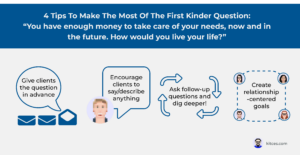 Why To Use George Kinder’s 3 Life Planning Questions With Financial Planning Clients – The ‘traditional’ goals-based approach to financial planning starts with clients articulating their goals and ends with the financial advisor providing recommendations about how best to achieve those goals. But in practice, one of the most important qualitative ways an advisor can add value to clients is by helping them identify and select meaningful goals, as the truth is that not everyone (or even most people) are really truly clear on what their goals are in the first place. And so, by asking the ‘right’ questions and building a bond with clients, an advisor not only ensures that their clients select appropriate goals but also creates ties that will encourage them to remain clients for years to come.
Why To Use George Kinder’s 3 Life Planning Questions With Financial Planning Clients – The ‘traditional’ goals-based approach to financial planning starts with clients articulating their goals and ends with the financial advisor providing recommendations about how best to achieve those goals. But in practice, one of the most important qualitative ways an advisor can add value to clients is by helping them identify and select meaningful goals, as the truth is that not everyone (or even most people) are really truly clear on what their goals are in the first place. And so, by asking the ‘right’ questions and building a bond with clients, an advisor not only ensures that their clients select appropriate goals but also creates ties that will encourage them to remain clients for years to come.
George Kinder, the founder of Life Planning, developed 3 questions that probe deeper into a client’s hopes, dreams, and fears, to help advisors develop complete and impactful financial plans. The first of these questions asks clients to dream about their future and freedom, brainstorming how they would live their life if they were financially secure. The question is open and exploratory, creating the perfect environment for the client to provide more insight into their true (often previously unstated) goals and priorities.
Notably, though, asking such ‘deep’ questions can be off-putting to clients who aren’t ready for it. As a result, while Registered Life Planners typically bring up the Kinder questions with clients without warning (as they have extensive training to handle the ‘shock’ value of the questions), other advisors with no Life Planning training might consider giving clients advance notice so they can start to consider their answers and help both parties be more comfortable with the discussion. And during the client meeting, it is important for the advisor to ask several follow-up questions, not only to keep the conversation flowing but also to help clients further clarify their goals. These questions could explore the client’s motivations, who else is with them when imagining their best life, and how their dream differs from their current situation.
Altogether, Kinder’s first question is a valuable tool for advisors to work constructively with clients to help them discover their true goals. Which not only helps clients better understand what they are really looking for in life, but also allows the advisor to create a better financial plan and enhance client loyalty!
Why Checklist-Style Financial Planning Works: What Advisors Can Learn From Dave Ramsey’s Baby Steps – There are many financial advisors who take issue with the financial advice offered by popular personal finance personalities such as Dave Ramsey. But Ramsey's huge following in the general public – and the number of people who testify that his methods have helped them make progress towards their financial goals – suggests that there is clearly something in his approach that resonates with many people.
One core element of Ramsey's teachings is his "Baby Steps" process for building wealth, which lays out a 7-step sequence for everyone to follow. Though many potentially valid criticisms of this process tend to concern technical details (e.g., the ideal size for an emergency fund), what makes Ramsey's Baby Steps so popular among the general public is that they are easy to implement; they are geared towards getting the individual to take action with as little friction as possible (in contrast to more advanced steps that would require additional research or analyses to complete).
For advisors, the key takeaway from this approach is that there could be merit in providing clients with a clear and cohesive set of steps (similar to a checklist) that help them orient themselves in terms of where they currently stand in the process and what actions lie ahead. As while many financial advisors may bristle against the idea of a more ‘rules-of-thumb’ checklist-style approach to planning, the broad-based success of Ramsey’s similar approach again highlights that sometimes it’s more important to get an ‘approximately’ right recommendation that is easy for clients to implement, than a precisely right recommendation that is too overwhelmingly detailed to take action on. Additionally, a checklist-based framework may even help advisors be more efficient in their planning since it can be a way to systematize the planning process into a set of repeatable steps across many clients (particularly if the advisor serves a specific niche where the steps for building wealth might really be similar across the advisor's whole client base)!
The key point is that a checklist-style approach may be challenging for financial advisors who revel in conducting detailed analyses and developing in-depth financial planning recommendations for clients, but in practice, it can provide clients with a better understanding of not only what actions they should take immediately but also the goals they are working towards in the long run, helping to actually motivate clients to action… in addition to potentially helping the advisor run a more efficient practice, too!
Retirement
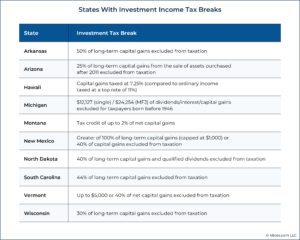 The Most Tax-Friendly States For Retirees: How To Compare State Income Tax Options For Retiring Clients – When evaluating their potential options across the U.S., a state’s income tax rules can have a significant impact on where a retiree might choose to live. However, while some states have the perception of being ‘high tax’ based on their ‘headline’ tax rate (i.e., the top tax rate imposed on the highest income tax bracket), in reality, the top marginal income tax rates don’t usually tell the whole story, at least not for retirees, because many states (including those typically labeled as ‘high-tax’) feature a slew of different tax breaks that can significantly reduce the tax burden for retirees in those states.
The Most Tax-Friendly States For Retirees: How To Compare State Income Tax Options For Retiring Clients – When evaluating their potential options across the U.S., a state’s income tax rules can have a significant impact on where a retiree might choose to live. However, while some states have the perception of being ‘high tax’ based on their ‘headline’ tax rate (i.e., the top tax rate imposed on the highest income tax bracket), in reality, the top marginal income tax rates don’t usually tell the whole story, at least not for retirees, because many states (including those typically labeled as ‘high-tax’) feature a slew of different tax breaks that can significantly reduce the tax burden for retirees in those states.
State tax breaks for retirees usually come in 4 flavors: no income tax at all; exclusion of Social Security income from taxable income; exclusion of pension or retirement plan withdrawals; and additional exemptions, deductions, or credits for all taxpayers above certain age thresholds. Every state features at least one of these types of tax breaks benefiting retirees, meaning that retirees will almost always pay a lower overall tax rate (depending on the types of income they have) than those who are still working full-time (though there are many nuances and exceptions included in the different state tax codes).
In the end, even though it might not be necessary for an advisor to attain a thorough grasp of all 50 states’ tax policies, knowing some of the key elements to look for when considering a given state (e.g., the tax treatment of interest, dividends, and capital gains for older residents) can create a deeper understanding of the true impact of income tax from living in a certain state. And for some clients, it might even expand the potential list of states beyond what they previously considered affordable!
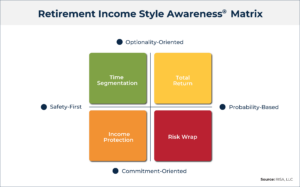 The RISA Framework: A Systematized Approach To Personalizing Retirement Income Strategies For Clients – Retirement income planning is at the center of many advisors’ value propositions. But while some advisors may rely on a single ‘favorite’ income strategy to recommend to clients, recognizing that retirees actually have a range of preferences on how to source their retirement income can help advisors better develop sensible strategies that clients may be more inclined to follow.
The RISA Framework: A Systematized Approach To Personalizing Retirement Income Strategies For Clients – Retirement income planning is at the center of many advisors’ value propositions. But while some advisors may rely on a single ‘favorite’ income strategy to recommend to clients, recognizing that retirees actually have a range of preferences on how to source their retirement income can help advisors better develop sensible strategies that clients may be more inclined to follow.
In their research, guest authors Alejandro Murguía and Wade Pfau identified the 2 strongest constructs that help to determine a client’s income preference style, consisting of Probability (depending on market returns) versus Safety (sources of income less reliant on market returns), and Optionality (having the flexibility to respond to economic developments or changing personal situation) versus Commitment (being dedicated to 1 retirement income solution). Together, these constructs are used to create a 2´2 framework that can be used to identify an individual’s Retirement Income Style Awareness (RISA) profile.
For advisors, the RISA framework can be used to determine a prospect’s or client’s preferences, which can then help the advisor design an appropriate and practical retirement income strategy. For example, a client who expresses a preference for Probability and Optionality would likely favor the potential upside from strong market returns and the option to change course as necessary that are offered by a Total Return income strategy, while a client who prefers Safety and Commitment may align better with an Income Protection approach, which could involve building a lifetime income floor with simple income annuities. Alternatively, advisors who really only prefer to implement in 1 or 2 domains of the RISA framework can use the tool to better understand whether a prospective client is a good fit for their particular style (e.g., being able to screen out clients who have a strong preference for safety and guarantees from advisors who primarily focus on a market-based approach to investing for retirement).
Ultimately, the key point is that by having a structured process around assessing a client’s retirement income preferences, an advisor can begin to develop a retirement income strategy that will most likely appeal to a particular prospect or client (or match their existing strategy to the ‘right’ prospects). By doing so, advisors can not only add value to current clients by ensuring that the client’s retirement income strategy matches their preferences but can also attract new clients by better showing how their approach is personalized to the client’s preferences for generating retirement income!
Tax
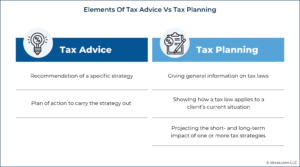 Tax Advice Restrictions For Financial Advisors: How To Offer Tax Planning And Remain In Compliance – Despite the prominent role of taxes in financial planning, advisors are often prohibited by their compliance departments from making recommendations for a specific course of action on a certain tax strategy. Which means that advisors are often left to figure out on their own how to guide their clients on tax-related matters without crossing the line into ‘Tax Advice’, which can potentially create certain liability issues for the advisor and their firm.
Tax Advice Restrictions For Financial Advisors: How To Offer Tax Planning And Remain In Compliance – Despite the prominent role of taxes in financial planning, advisors are often prohibited by their compliance departments from making recommendations for a specific course of action on a certain tax strategy. Which means that advisors are often left to figure out on their own how to guide their clients on tax-related matters without crossing the line into ‘Tax Advice’, which can potentially create certain liability issues for the advisor and their firm.
For advisors who are prohibited from giving tax advice, tax planning can be an alternative approach for discussing tax matters with clients. Tax planning can range from giving general, nonspecific information on tax laws and regulations to creating detailed projections for clients and comparing the outcomes of potential tax strategies – so long as the planning does not also include a recommendation of a specific course of action that would constitute tax advice. Generally, the more detailed the analysis, the likelier it could be construed by the client as a recommendation – which is what ultimately matters, since a presentation that the client understands to be tax advice is as good as actually giving tax advice. In these circumstances, safeguards such as upfront disclosures and collaboration with the client’s tax professional may be necessary to ensure that the tax professional – and not the advisor – is the one making the actual recommendation.
The key point is that understanding what constitutes tax advice versus tax planning that doesn’t go so far as to make a recommendation can help advisors more confidently engage with their clients on tax matters without violating the unique rules set in place by their compliance departments. Having a framework for the types of advice to give and for the language to use when communicating strategies to clients can reduce the confusion of being obliged to provide guidance on taxes while being prohibited from giving actual tax advice. Because ultimately, the question around tax planning (if not outright advice) isn’t whether it should be offered, but how it can be delivered to provide the most value to clients while protecting the client, advisor, and firm!
 Why The Value Of A Roth Conversion Is Calculated Using (True) Marginal Tax Rates – Roth conversions are, in essence, a way to pay income taxes on pre-tax retirement funds in exchange for future tax-free growth and withdrawals. But the decision of whether to complete a Roth conversion is not as simple as just ‘automatically’ paying taxes today for tax-free growth in the future, as the reality is that if tax rates are too high today, it may have been better to simply wait and pay the tax bill in the future at lower rates! However, comparing a client’s federal and state tax bracket today with the expected future bracket for pre-tax withdrawals to find the optimal balancing point isn’t necessarily better, either. This is because, for many individuals, the tax bracket alone doesn’t accurately reflect the real impact of the Roth conversion and when best to time it. Because of the structure of the tax code, there are often ‘add-on’ effects created by adding or subtracting income – and these effects aren’t accounted for when simply looking at one’s tax bracket.
Why The Value Of A Roth Conversion Is Calculated Using (True) Marginal Tax Rates – Roth conversions are, in essence, a way to pay income taxes on pre-tax retirement funds in exchange for future tax-free growth and withdrawals. But the decision of whether to complete a Roth conversion is not as simple as just ‘automatically’ paying taxes today for tax-free growth in the future, as the reality is that if tax rates are too high today, it may have been better to simply wait and pay the tax bill in the future at lower rates! However, comparing a client’s federal and state tax bracket today with the expected future bracket for pre-tax withdrawals to find the optimal balancing point isn’t necessarily better, either. This is because, for many individuals, the tax bracket alone doesn’t accurately reflect the real impact of the Roth conversion and when best to time it. Because of the structure of the tax code, there are often ‘add-on’ effects created by adding or subtracting income – and these effects aren’t accounted for when simply looking at one’s tax bracket.
For example, when an individual is receiving Social Security benefits, adding income in the form of a Roth conversion could increase the amount of Social Security benefits that are taxed so that the increase in taxable income caused by the Roth conversion is more than ‘just’ the amount of funds converted. However, the same effects are also true on the ‘other’ end of the Roth conversion, where any reduction in tax caused by replacing pre-tax withdrawals with tax-free Roth withdrawals could also be magnified by an accompanying decrease in the taxability of Social Security benefits.
In fact, there is a wide range of additional factors that can impact tax outcomes beyond just an individual’s tax bracket, including IRMAA (income-related monthly adjustment amounts) for Medicare premiums that kick in at higher income levels, the phaseout of premium assistance tax credits or the qualified business income deduction, the deduction for medical expenses, and more.
In the end, finding the ‘true’ marginal rate of the conversion (i.e., the increase or decrease in tax that is solely attributable to the conversion itself) is the only way to fully account for its impact and fully incorporate all of these different factors. Additionally, understanding the true marginal rate can make it possible to time conversions in order to minimize the negative add-on effects (e.g., avoiding Roth conversions when doing so will also increase the taxation of Social Security benefits) and maximize the positive effects (e.g., using funds converted to Roth to reduce pre-tax withdrawals when doing so will decrease the taxation of Social Security) – thus maximizing the overall value of the decision to convert assets to Roth!
 Maximizing The Step-Up In Basis By Gifting Assets Between Spouses – The step-up in basis at death can be a powerful planning tool for minimizing an individual’s capital gains taxes from the sale of appreciated assets. For married couples living in ‘separate property’ states, though, the death of one spouse often only results in a partial step-up, reducing the value of the tax benefit for the surviving spouse (although those who live in 1 of the 10 ‘community property’ states receive a full step-up on all jointly held assets). But with some proactive planning, couples can take greater advantage of the step-up rules by titling their assets in a way that maximizes their likelihood of a full step-up.
Maximizing The Step-Up In Basis By Gifting Assets Between Spouses – The step-up in basis at death can be a powerful planning tool for minimizing an individual’s capital gains taxes from the sale of appreciated assets. For married couples living in ‘separate property’ states, though, the death of one spouse often only results in a partial step-up, reducing the value of the tax benefit for the surviving spouse (although those who live in 1 of the 10 ‘community property’ states receive a full step-up on all jointly held assets). But with some proactive planning, couples can take greater advantage of the step-up rules by titling their assets in a way that maximizes their likelihood of a full step-up.
For instance, couples living in separate-property states where one spouse is expected to live longer than the other may transfer all of their assets solely into the name of the spouse anticipated to die first. Upon that spouse’s death, 100% of those assets would be subsequently included in their estate and, therefore, be subject to a full step-up when the surviving beneficiary spouse receives the assets.
As with many seemingly simple strategies, however, the transfer-and-inherit strategy between spouses comes with complications and exceptions to watch out for. For example, the spouse who receives the transfer of assets must own them for at least 1 year before they pass back to the original donor (or an anti-abuse tax rule prevents the benefits of the step-up in basis). In addition, transferring assets to the name of a spouse enrolled in Medicaid (or who plans to enroll in the future) could exceed the allowable asset limit for Medicaid eligibility (gaining a step-up in basis at what might be the cost of even more lost in government benefits to support future long-term care needs).
Ultimately, the difference between a full step-up in basis and a partial one (or none at all) can result in a significant increase in the after-tax value of assets for some clients. And so, advisors can help deliver this value to their clients by planning and aiding with the retitling of assets (when appropriate) to take full advantage of the basis step-up!
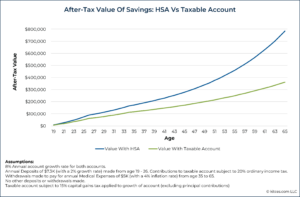 Maximizing Health Savings Accounts (HSAs) Tax Benefits With Adult Children Under Age 26 – Health Savings Accounts (HSAs) are one of the most popular savings vehicles because of their triple-tax advantage for account owners: above-the-line tax deductions for eligible contributions, tax-deferred growth in the account, and tax-free withdrawals for qualified healthcare expenses.
Maximizing Health Savings Accounts (HSAs) Tax Benefits With Adult Children Under Age 26 – Health Savings Accounts (HSAs) are one of the most popular savings vehicles because of their triple-tax advantage for account owners: above-the-line tax deductions for eligible contributions, tax-deferred growth in the account, and tax-free withdrawals for qualified healthcare expenses.
To contribute to an HSA, an individual must be covered by a High Deductible Health Plan (HDHP), have no other health coverage (including Medicare enrollment), and not be claimable as a dependent on someone else’s tax return. Notably, the account owner does not have to be covered under their own healthcare plan, though, so a young adult (under age 26) who is covered under their parents’ HDHP plan (and who would not qualify as a dependent on their parents’ tax return) would potentially be eligible to contribute to their own HSA. Further, while spouses can only make combined contributions up to the family maximum contribution limit ($7,300 in 2022), non-spouses covered under the same health plan (e.g., young adult children who meet the contribution criteria) can make contributions to their own HSA up to the family limit as well! Effectively allowing a family with adult children under the age of 26 to ‘double dip’ by contributing to multiple HSAs under a single HDHP family plan… which in some cases may be so appealing that a family switches to an HDHP just to qualify for the multiple-HSA-contribution opportunity!
However, because HSA owners must be covered under an HDHP in order to contribute, it is important to first consider whether choosing an HDHP is the best choice given a family’s medical expenses and financial situation, as those with a high likelihood of medical-expense needs could end out paying more in actual claims than they generate in tax savings by being able to contribute to multiple HSAs (or alternatively, may not have enough left to contribute to HSAs after covering their family’s high deductible under the plan). This presents an opportunity for advisors to assess whether the tax benefits of HSAs outweigh the costs of opting for HDHP coverage (which typically has lower premiums but higher deductibles relative to traditional health insurance plans).
Ultimately, the key point is that because children are now allowed to remain on their parents’ health insurance plans until age 26, non-dependent children covered under a family HDHP may be eligible to contribute to their own HSAs, which can provide enough of a benefit to make families with adult children consider switching to an HDHP if they’re not on one already. And as HSAs offer significant tax advantages, advisors can help clients ensure that opting for HDHP coverage makes sense financially for the family as a whole!
Investments
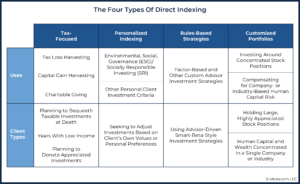 The Four Types Of Direct Indexing And Technology Solutions For Advisors – Historically, direct indexing – buying the individual component stocks within an index rather than an index ETF or mutual fund – was developed as a means to unlock the tax losses of individual stocks in an index (even if the index itself was up) and was primarily used only by the most affluent investors (who had the highest tax rates and benefitted the most from the available loss harvesting of those individual stocks).
The Four Types Of Direct Indexing And Technology Solutions For Advisors – Historically, direct indexing – buying the individual component stocks within an index rather than an index ETF or mutual fund – was developed as a means to unlock the tax losses of individual stocks in an index (even if the index itself was up) and was primarily used only by the most affluent investors (who had the highest tax rates and benefitted the most from the available loss harvesting of those individual stocks).
But thanks to reduced trading costs and emerging direct-indexing-technology platforms, the strategy is viable for a broader range of use cases and clients, including those clients who want to gain broad market exposure while adjusting for personal preferences (e.g., ESG/SRI criteria); advisors who want to overlay various rules (e.g., factor tilts) on top of an index to implement their own proprietary investment strategy; advisors who want to build their client’s portfolio around a large, highly appreciated, or concentrated investment position; or clients whose human capital is tied up in (and leaving them over-exposed to) one particular company or industry.
Notably, the distinctions between the 4 types of direct indexing are important, as the various uses of direct indexing necessitate very different capabilities from the platforms themselves. Which, in turn, means that multiple different indexing providers can each have the potential for breakout success by building the best-in-class solution for a particular direct indexing approach… while recognizing that what it takes to be most successful in one direct-indexing category may be very different from what it takes in others (e.g., direct-indexing technology to help clients make their own personalized values-based portfolios will show up very differently than technology to help advisors build ‘completion’ portfolios around a client’s existing concentrated stock position).
Ultimately, the key point is that the value of direct indexing is no longer limited to tax benefits of tax-loss harvesting individual stocks for high-net-worth clients (though that does remain one valid use case!). The developing uses for direct indexing – personalized indexes, rules-based investment strategies, and customized completion portfolios – can benefit a wider range of advisors and their clients!
Podcasts
#FA Success Ep 267: Making The Business ‘Fun’ Again By Focusing On Your Core And Outsourcing The Rest, With Jared Siegel – Running a financial planning firm comes with a wide range of responsibilities, from prospecting for and meeting with clients to back-office operational and compliance duties. And when a firm reaches a certain size, the sheer number of tasks to complete can become overwhelming for a single individual.
In this episode, Jared Siegel discusses the process his firm went through to add financial planning services to a long-standing accounting practice. As the financial planning practice grew, he reached a point of unhappiness when he realized he was spending far too much of his own time on tasks he didn’t enjoy (and wasn’t very good at) instead of doing the client-facing financial planning he loves.
Jared started by hiring a client service associate to deal with client paperwork and interface between his firm and the custodian. And after this first associate earned their CFP marks and became the firm’s first employee advisor, he hired another client service associate, followed by another advisor with an understanding of several financial-related industries. However, when it came to the investment side of the business, Jared ultimately decided not to continue hiring and creating more positions for himself to manage; instead, he transferred investment management operations to a TAMP, allowing his firm to focus on its core value proposition of financial and tax planning.
Ultimately, the key point is that by taking advantage of strategic hires combined with outsourcing opportunities, Jared has not only built a successful planning practice but has also done so while spending most of his time on responsibilities that match his strengths and interests!
#FA Success Ep 297: From $0 To $70M In 2 Years By Leveraging Facebook Groups To Share Authentic Expertise, With Andy Panko – When starting a financial planning firm, one of the biggest challenges is building up a base of clients. Traditional options to do so include tapping the advisor’s network (e.g., family and friends), being listed on ‘find-an-advisor’ websites, and networking through centers of influence (e.g., lawyers and accountants). But many of these tactics take time to be effective, so the first couple of years in a new firm’s life can be difficult.
In this episode, Andy Panko discusses how, after trying many of the traditional marketing techniques, he grew his client base quickly by creating and developing a Facebook group centered on his firm’s focus on tax-efficient retirement planning. In fact, he reached the client capacity goal he set out in just 2 short years, growing quickly from $0 in AUM to $70 million!
Andy has grown his Facebook group to more than 30,000 people by demonstrating his expertise in retirement planning and responding quickly to group members’ questions. Which has led to a positive cycle of members referring others to the group, growing it further. And while 99% of group members are only there for the free content, the sheer size of the group has meant that even a small minority deciding they want to work with an advisor has been enough to fill his client ranks (and has allowed him to refer members out to other advisors as well, as Andy reaches his personal client capacity!).
In the end, Andy has found success by offering his expertise for free to those in his Facebook group but has reaped the financial benefits of attracting a small subset of group members as clients. In addition, his experience also shows that advisors do not need to be power users of a wide range of platforms to benefit from exposure to social media!
#FA Success Ep 302: Structuring Your Ideal Week To Become A Highly-Leveraged Individual Advisor, With Libby Greiwe – For advisory firm owners, it can often be tempting to work more and more hours each week to grow their client roster and serve their current clients. But while this brute-force approach can sometimes be effective in generating revenue, it can come at the cost of burnout and a lack of time to spend with family and on other activities.
In this episode, Libby Greiwe discusses how she reduced her workload to 25 hours per week while running a thriving practice, thanks in part to developing an “Ideal Week” approach in which she structured her time and activity levels to match her energy and responsibilities. This allowed her to block out specific times for client engagements, team meetings, and administrative tasks (e.g., checking email) in an organized way to help prevent her work duties from seeping into her personal time.
Implementing this Ideal Week approach required Libby to build a team, which started with deciding on the specific role she wanted to hire and then finding someone with matching skills. In addition, she refined her idea of success (which included living a full life outside of the office), fine-tuned her client experience (to avoid being tempted by ‘shiny-object’ services she could offer that would cost her time), and narrowed her firm’s niche to the point they focused on executives from only 2 companies.
Altogether, Libby’s experience demonstrates the value for firm owners of stepping back and considering not only whether their practice is operating the way they want but also whether they are living the life they want to live. And whether it is by implementing an Ideal Week approach, building a staff, or focusing on a client niche, advisors have several ways to run a more efficient practice and spend more time away from the office!
Kitces & Carl Ep 89: From Financial Plan Software To One Page Financial Planning – Financial advisors have traditionally presented financial plans to clients in the form of a thick, bound, all-encompassing document that not only provides an in-depth roadmap for clients but also demonstrates the expertise and value financial advisors offer. But given the potential weaknesses of this approach, from the difficulty clients often have parsing such a detailed tome to the challenges of revising it, Carl Richards developed an alternative: The One-Page Financial Plan, which focuses on the most important information a client needs to know in a 1-page report.
In this episode, Michael and Carl discuss how the 1-page plan has taken the advisory world by storm, going from a concept that was initially received with skepticism to a key part of the advisory toolbox that is now included in many financial planning software programs (that were previously responsible for the thick reports of yore!).
As a starting point, though, it’s important to understand that financial snapshots don’t replace the work of creating a full financial plan itself. Rather, a 1-page plan is an alternative to the deliverable for the client that not only saves the advisor (and the client) time by being shorter to produce but also provides a living document for the advisor and the client that is easily updated over time throughout the advisor-client relationship.
And while advisors in the past may have been likened to ‘mapmakers’ solely responsible for creating a plan, changes in technology and digital communication have enabled financial advisors to do full, in-depth analyses while connecting with clients to update their plans more dynamically and, in the process, serving more as ‘guides’ on their clients’ financial journeys.
Ultimately, the key point is that thanks to flexible tools like the 1-page financial plan, advisors can focus on building more dynamic relationships with their clients instead of just creating a static path for clients to reach their financial goals. Because going on the journey together with clients can increase touchpoints throughout the relationship, which increases trust and deepens relationships!
Kitces & Carl Ep 93: Getting An ROI From Your New Associate Advisor (In Less Than 6 Years) – Historically, the career path for newer financial advisors was to be hired into a sales-focused role where sales training took center stage, and the technical aspects of financial planning didn’t get developed until later along the way. This ‘eat-what-you-kill’ approach might not have worked well for many newer advisors (who were starting from scratch), but it lowered the bar for firms in hiring, as new hires would bring in revenue right away (or soon drop off the employee roster). But now, as the career progression for many planners starts with building financial planning skills first and sales skills later, firms are sometimes hesitant to bring on employees when they might not generate new revenue for the firm for several years.
In this episode, Michael and Carl discuss how junior employees can add value to a firm during their formative years, even while not bringing in new business. First off, a new associate advisor can add value by taking tasks off of a firm owner’s plate (e.g., initial plan preparation), allowing them to focus on tasks that require their expertise and are likely to have a greater impact on the firm’s bottom line (e.g., meeting with clients and business development). In addition, while it will take a new hire several years to gain the broad-based knowledge and experience needed to become a lead advisor, they can still develop areas of focus that can inform the work of more senior advisors (e.g., learning the ins and outs of different types of new annuity products).
The key point is that firms can get value from hiring a new associate advisor almost immediately, even if they will not be responsible for bringing in new clients for several years. From freeing up the firm owner’s time for more profitable activities to growing the firm’s expertise, associate advisors can add significant value to a firm, whether or not they become revenue-generating lead advisors down the line!
Kitces & Carl Ep 98: Fee Schedule Complexity And Managing The Fear Of Leaving Opportunities On The Table – When designing their website, financial advisors often try to attract as many visitors as possible in an attempt to broaden the pool who might respond to a call to action. In turn, by trying to appeal to everyone who is willing to become a client, advisors often create ‘flexible’ fee schedules to accommodate that wide range of prospects, at the risk that, sometimes, those fee schedules have so many layers of complexity to fit all possible situations that prospects end out too confused to understand what the advisor can actually do for them and don’t choose any of the available options!
In this episode, Michael and Carl discuss how, ironically, trying to cater to all potential clients’ needs can actually make it less likely that the prospect will respond to a ‘call to action’ to work with the advisor… because they are no longer able to see how the advisor will address their specific problems in the midst of all the fee choices available.
As a starting point to evaluate the problem for themselves, advisors can check out Google Analytics as a helpful tool to find out how many individuals are visiting their site each month; many small firm owners might be surprised at how many visitors they have (who aren’t becoming prospects!). The flip side, though, is that some firms (particularly those who are trying to appeal to ‘everyone’) will see very low conversion rates on these visitors. On the other hand, advisors who focus the content of their website on the needs of a specific ideal-target client often see a higher conversion rate, as those clients will see how they could be served by the advisor (even if the other 99% of website visitors cannot relate to the advisor’s target client).
Ultimately, the key point is that trying to cater to all prospective clients out of fear of leaving opportunities on the table – and developing complex fee schedules to meet all of those clients’ needs – may feel like it creates more opportunities with prospects, but will often only serve to dilute an advisor’s perceived value proposition by presenting too many choices. But by selecting an ideal target client and focusing their website on their planning needs, advisors can increase their conversion rate and ultimately see stronger growth!






Leave a Reply